Parsonstown, Co. Offaly (King's County)
Parsonstown (now known as Birr) Poor Law Union was formally declared on the 8th May 1839 and covered an area of 234 square miles. Its operation was overseen by an elected Board of Guardians, 29 in number, representing its 21 electoral divisions as listed below (figures in brackets indicate numbers of Guardians if more than one):
King's County: Banagher (2), Drumcullen, Eglish, Ferbane, Frankfort (2), Kilcoleman, Kinnety, Lemanagan (2), Letter, Lusmagh, Seirkyrans, Parsonstown (3), Shannon Bridge (2), Shannon Harbour (2), Tissarin.
Co. Tipperary: Aglishcloghane, Ballingarry, Dorha (2), Lockeen, Lorha (2), Uskeane.
The Board also included 9 ex-officio Guardians, making a total of 38. The Guardians met each week on Saturday.
The population falling within the Union at the 1831 census had been 71,138 with divisions ranging in size from Letter (population 1,000) to Parsonstown itself (8,744).
The new Parsonstown Union workhouse was erected on a seven-acre site half a mile to the east of Parsonstown. Designed by the Poor Law Commissioners' architect George Wilkinson, the building was based on one of his standard plans to accommodate 800 inmates. Its construction cost £6,900 plus £1,384 for fittings etc. The workhouse was declared fit for the reception of paupers on 14th March 1842, and received its first admissions on 2nd April. The workhouse location and layout are shown on the 1912 map below.
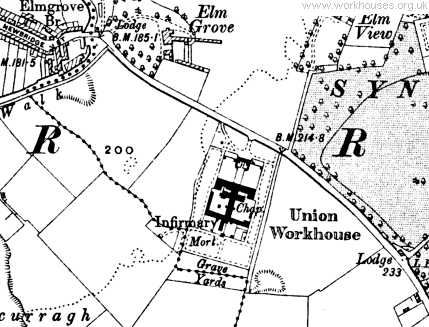
Parsonstown workhouse site, 1912
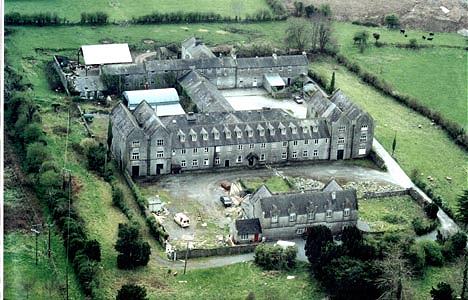
Parsonstown aerial viw from the east
© Paul Barber.
The buildings followed Wilkinson's typical layout. An entrance and administrative block at the north-east of the site contained a porter's room and waiting room at the centre with the Guardians' board room on the first floor above.
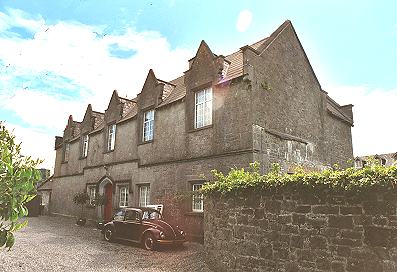
Parsonstown workhouse site entrance from the north, 2002
© Peter Higginbotham.
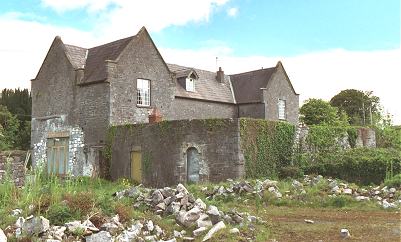
Parsonstown workhouse site from the west, 2002
© Peter Higginbotham.
The main accommodation block had the Master's quarters at the centre, with male and female wings to each side.
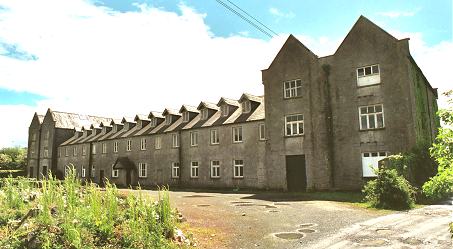
Parsonstown workhouse site from the north, 2002
© Peter Higginbotham.
At the rear, a range of single-storey utility rooms such as bakehouse and washhouse connected through to the infirmary and idiots' wards via a central spine containing the chapel and dining-hall.
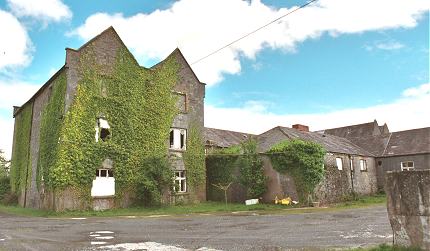
Parsonstown main block and utility block from the west, 2002
© Peter Higginbotham.
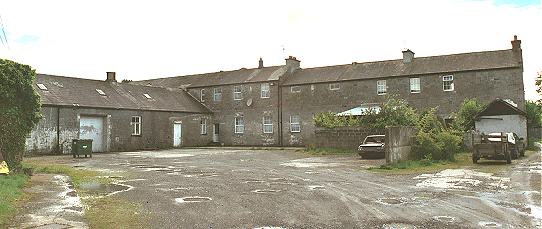
Parsonstown central spine and infirmary block from the north, 2002
© Peter Higginbotham.
During the famine in the mid-1840s, fever patients were sent to the town fever hospital. Plans were also prepared for the erection of sheds in which to accommodate fever patients.
In 1852, the southern part of the Parsonstown Union went to become part of the new Borrisokane Union.
At the 1901 census, the population of the Union was 25,332.
Most of the workhouse buildings survive and are currently used as residential accommodation.
Staff
In 1905, workhouse staff were as follows:
- Master - Benjamin Rudds
- Matron - Margaret Kilmartin
- Chaplains - Rev. Preb. Samuel Hemphill (COI), Very Rev. John Scanlon (RC)
- Medical Officer - Thomas Woods
Records
Note: many repositories impose a closure period of up to 100 years for records identifying individuals. Before travelling a long distance, always check that the records you want to consult will be available.
- Offaly Archives, Offaly Archives Unit 1F, Axis Business Park, Clara Road, Tullamore, Co Offaly.
Bibliography
- Crossman, V (2006) Politics, Pauperism and Power in Late Nineteenth-century Ireland
- Gray, P (2009) The Making of the Irish Poor Law, 1815-43
- O'Brien, G (1985) The New Poor Law in Pre-Famine Ireland: A Case Study (in Ir. Econ. Soc. Hist., XII, 35-49)
- O'Connor, J (1995) The Workhouses of Ireland
Links
- None.
Acknowledgment
- Thanks to Paul Barber for use of the photo and to Margaret Hogan for providing it.
Unless otherwise indicated, this page () is copyright Peter Higginbotham. Contents may not be reproduced without permission.


